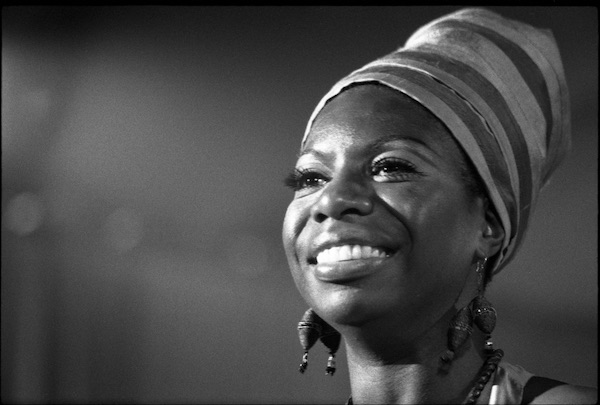Oct 28, 2025 10:47 AM
In Memoriam: Jack DeJohnette, 1942–2025
Jack DeJohnette, a bold and resourceful drummer and NEA Jazz Master who forged a unique vocabulary on the kit over his…

Nina Simone radiates joy on a reissue of Fodder On My Wings.
(Photo: Jean-Pierre Leloir)With the possible exception of John Coltrane, no jazz artist from the ’50s and ’60s has had their iconic status recharged more powerfully in the present than Nina Simone, whose fierce expressions of Black pride and womanhood reverberate more than ever. She was suffering from mental illness when she recorded Fodder On My Wings (Verve/UMe B003115802; 44:49 ****) in France in 1982. But she transcends her condition, radiating joy with upbeat tunes and artfully reining in her anger on the laments. Typically, the moodiest tunes on Fodder, including her transformation of “Alone Again (Naturally)” into a brooding epic about her father’s death, have drawn the most critical attention. (The Gilbert O’Sullivan hit is one of three bonus tracks from a 1988 French reissue.) But equally worthy are “Liberian Calypso,” which boasts a punchy horn arrangement and lighthearted theatricality: “Hey, Nina!” her background singers call out, charmed by her patois. And “Heaven Belongs To You,” a gospel-driven winner, occasions some spoken autobiography. “I learned it in English, even though it’s an African song,” Simone said, celebrating her American birthright.
Though the release of Art Blakey & the Jazz Messengers’ Just Coolin’ (Blue Note 64201; 38:59 ****) is attached to Blue Note’s ongoing reissue campaign in celebration of the bandleader’s centennial, this 1959 studio effort never had been issued before. A few months after it was recorded, label head Alfred Lion captured the same ensemble at Birdland, after which he decided to shelve Just Coolin’ and release four of its tracks in extended live versions on Art Blakey & the Jazz Messengers At The Jazz Corner Of The World. More than 60 years later, this studio album arrives like a long-unopened gift, attaining rarefied heights of its own via the quintet’s elegant sense of control and nuanced blues. Rejoining the Messengers after several years, in a place-holding role ahead of Wayne Shorter’s arrival, the ineffable tenor saxophonist Hank Mobley wrote three of the six songs, including the title track, a loosey-goosey foxtrot and the warmly relaxed, groove-tight “Hipsippy Blues.” Released for the first time are pianist Bobby Timmons’ sturdy and soulful “Quick Trick” and the uncredited “Jimerick,” a speedy, stop-start hard-bop vehicle on which Mobley is in prime-ripping mode and the bandleader defies gravity with his levitational solo.
The Giant Is Awakened (Real Gone Music 1012; 38:49 *****), the Horace Tapscott Quintet’s memorable document of late-’60s Los Angeles, was reissued on CD in 2014 by the classy International Phonograph label. Now, the recording makes its first appearance on LP—on neon green vinyl, no less—since its original 1969 release on Flying Dutchman. A sometimes hypnotic, sometimes starkly expressive reflection of those fractious times, Giant opens with a fervent battle cry from alto saxophonist Arthur Blythe (making his recording debut) and never lets up in intensity. Alternating between and sometimes juxtaposing keening calls to action and minimalist, folk-tinged melodies, the band is powered by pianist Tapscott’s stormy percussive attack, which sometimes makes the acoustic keys seem electric. With its swooshing effects and two bassists, David Bryant and Walter Savage Jr. (the drummer is Kansas Cityite Everett Brown Jr.), the album is ahead of its time. To the great disappointment of those who thrilled at this music, Tapscott didn’t make another recording for 10 years. But Giant is as enrapturing now as it was then.
In reissuing the fine Seattle-based trio New Stories’ Speakin’ Out (Origin 82372; 67:24 ***1/2) on the occasion of the album’s 20th anniversary, the Origin imprint celebrates one of its key releases—and, in “Highway Blues,” which became a worldwide phenomenon after being embedded in Windows XP operating system, one of the label’s key tracks. Composed by pianist Marc Seales, the song is ignited by saxophone great Ernie Watts’ muscular, Coltrane-esque solo. Watts also lifts four other band-penned originals, and the album includes fresh three-man covers of Herbie Hancock’s “I Have A Dream” and Pat Metheny’s “In Her Family.” DB
This story originally was published in the June 2020 issue of DownBeat. Subscribe here.

Jack DeJohnette boasted a musical resume that was as long as it was fearsome.
Oct 28, 2025 10:47 AM
Jack DeJohnette, a bold and resourceful drummer and NEA Jazz Master who forged a unique vocabulary on the kit over his…

D’Angelo achieved commercial and critical success experimenting with a fusion of jazz, funk, soul, R&B and hip-hop.
Oct 14, 2025 1:47 PM
D’Angelo, a Grammy-winning R&B and neo-soul singer, guitarist and pianist who exerted a profound influence on 21st…

Kandace Springs channeled Shirley Horn’s deliberate phrasing and sublime self-accompaniment during her set at this year’s Pittsburgh International Jazz Festival.
Sep 30, 2025 12:28 PM
Janis Burley, the Pittsburgh International Jazz Festival’s founder and artistic director, did not, as might be…

Jim McNeely’s singular body of work had a profound and lasting influence on many of today’s top jazz composers in the U.S. and in Europe.
Oct 7, 2025 3:40 PM
Pianist Jim McNeely, one of the most distinguished large ensemble jazz composers of his generation, died Sept. 26 at…

Drummond was cherished by generations of mainstream jazz listeners and bandleaders for his authoritative tonal presence, a defining quality of his style most apparent when he played his instrument unamplified.
Nov 4, 2025 11:39 AM
Ray Drummond, a first-call bassist who appeared on hundreds of albums as a sideman for some of the top names in jazz…